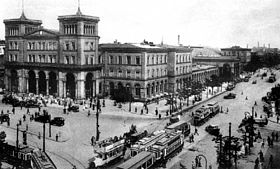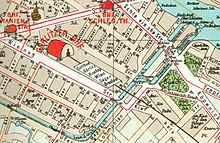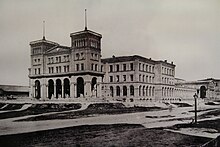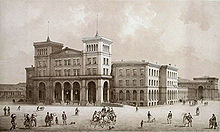Berlin Görlitzer Bahnhof
| Berlin Görlitzer Bahnhof | |
|---|---|
|
Spreewaldplatz with the Görlitz train station, 1928
|
|
| Data | |
| Design | Terminus |
| opening | September 13, 1866 |
| Conveyance | April 30, 1951 (passenger traffic) 1987 (freight traffic) |
| location | |
| City / municipality | Berlin |
| Place / district | Kreuzberg |
| country | Berlin |
| Country | Germany |
| Coordinates | 52 ° 29 '56 " N , 13 ° 25' 53" E |
| Railway lines | |
| Railway stations in Berlin | |
The Görlitzer Bahnhof was in Berlin district of Kreuzberg situated terminus and starting point of the railway line over Cottbus to Görlitz . The Görlitzer Park has been located on the extensive station area since the 1990s . Today only the nearby Görlitzer Bahnhof underground station bears the name Görlitzer Bahnhof .
In the north-west of the site is Spreewaldplatz, the former station forecourt . In the north, Lausitzer Platz closes the area with the Emmauskirche, which was built between 1890 and 1893 according to plans by August Orth , separated from the station area by the viaduct of the elevated railway line of the first Berlin subway, which runs on today's Skalitzer Straße . In the south, the site borders on the Landwehr Canal and thus on the Alt-Treptow district .
history
The Görlitzer Bahnhof was the end point of a private railway line of the "railway king " Strousberg , the Berlin-Görlitzer Eisenbahn , there with connections to Wroclaw and Vienna. Like the Emmaus Church, the neo-renaissance style station building is based on designs by the architect August Orth . Construction began in 1865. As the area was very extensive, a pedestrian tunnel was created as a shortcut for crossing pedestrians about in the middle under the station area between the end of Liegnitzer Strasse and Oppelner Strasse, popularly known as the "Görlitzer Tunnel".
Operational phase
The first train drove here on June 13, 1866: a military train to the Austro-Prussian War . On September 13, the section to Cottbus and thus the Görlitzer Bahnhof in Berlin was officially opened for passenger traffic, on December 31, 1867 the entire Görlitzer Bahn line went into operation. The Görlitzer Bahnhof was - like most long-distance train stations in Berlin - a terminus station .
The railway to Görlitz ran through the Spreewald and Lausitz , which is also reminiscent of the names of the surrounding squares. The station was connected to the gas works on Prinzenstraße (today: Böcklerpark / Prinzenbad ) via a track embedded in the pavement at the corner of Skalitzer and Gitschiner Straße , which was also supplied with coal on this route. In the 1914 timetable there were trains from Görlitz station via Cottbus to Görlitz and Breslau .
The Berlin U-Bahn has been passing Skalitzer Strasse since 1902, and it also stops at a high station of the same name .
In the 1930s, it was planned to give up the terminus and to connect the entire area via a tunnel route known as the East-West S-Bahn to the Anhalter Bahnhof . A station at Görlitzer Bahnhof was planned directly on Spreewaldplatz. After 1945 these plans were pursued by the Berlin Senate and only abandoned in 1985.
Second World War
Starting position

At the end of the Second World War , the Görlitzer Bahnhof was also a focal point of the fighting in the Battle of Berlin . After the city limits in east Berlin had been reached on April 21, 1945, the Soviet Marshal Zhukov deployed General Bersarin's 5th shock army from Lichtenberg against the Schlesischer Bahnhof (today: Ostbahnhof) and the Görlitzer Bahnhof to avoid the route through the southeastern one Abbreviate urban areas. With it he aimed via Kreuzberg into the city center .
Front area
The 5th Shock Army had crossed the city limits at Marzahn on April 21 and was in Friedrichshain on April 24 . Since the Oberbaum Bridge had been blown up in the middle on April 23, the Red Army crossed the Landwehr Canal from Treptow on April 25 . "The [Soviet] 9th Corps [...] was involved in violent fighting in the area around the Görlitz train station, which dominated the center of their front."
The focal point of the fighting was initially the railway bridges over the canal. After that, the entire site was included with its buildings.
"On the morning of April 26th, Krukenberg's units of the ' Nordland ' division launched a counterattack in Neukölln and on the grounds of the Görlitz train station - their opponents were units of the 4th Guard Corps and the 9th Corps" Bersarin. 'Nordland' is advancing successfully and is entrenched in Neukölln town hall in the area occupied by the enemy. "A group of Hitler Youth was sent as reinforcement". During the night the breakout succeeds in returning to one's own lines.
After this stubborn resistance, it was not until April 27 that "Bersarin's 9th Corps [...] penetrated Kreuzberg and reached Moritzplatz ."
By concentrating the artillery on the railway site, the surrounding districts of Kreuzberg SO 36 and Neukölln were largely spared from destruction.
post war period
The station building was also damaged by the fighting at the end of April 1945. On April 29, 1951, the last suburban train to Königs Wusterhausen was dispatched. One day later, the electric S-Bahn took over this connection via Ostkreuz without going through West Berlin .
After the end of the train service, the buildings were gradually demolished between 1961 and 1967 at the instigation of the then Building Senator Rolf Schwedler, despite protests from the Kreuzberg population. This was justified with the aim of rebuilding the railway area that is no longer needed, but this never took place. The construction of the southern bypass planned in the 1970s for the Berlin city motorway across the area of the train station never came about either. In the 1980s, an adventure pool was built under the name Bad am Spreewaldplatz , and a district park was built on the railway site according to plans by the Free Planning Group Berlin. The remaining goods sheds were included in the concept.
At Schöneweide station , the GDR operated customs clearance for West Berlin freight trains that ran from Neukölln to Görlitz station . On August 13, 1961, the connection was interrupted by the construction of the wall . After that, the Görlitz freight station could only be reached via a driveway from the Treptow freight station in Neukölln.

In the post-war period there were huge coal heaps on the site. From here part of West Berlin was supplied with fuel. Until 1985, freight trains still ran over the connection to companies located on the station premises (gravel store, warehouse of a forwarding company, scrap yard). A border crossing was specially set up for this at the Landwehr Canal Bridge. Remains of the iron viewing bridge at this point have been preserved to this day. Today a short piece of track east of the canal bridge and two former goods sheds in Görlitzer Park remind of the former use of the station.
In the late 1980s, the site was largely a freely accessible wasteland , which was used by the residents as a kind of oversized adventure playground. So large were regularly Johannis - and other fire festivals celebrated, and artists groups like the Mutoid Waste Company used the outdoor area for performances and other performances. In 1988, a large part of the Kreuzberg May riot took place on the station premises.
present
The Görlitzer Park has been located on the site of the old Görlitzer Bahnhof since the 1990s, and some of the remains of the station are integrated into it. In the south of today's park, for example, several railway bridges connected the station area with the Treptow district , one of which is still preserved and as a pedestrian bridge leads directly from the park south of the Lohmühleninsel over the Landwehr Canal. Also in the southern part of the site, in the corner formed by Görlitzer Ufer and Wiener Straße , there was a locomotive shed with a turntable .
The 170-meter-long pedestrian tunnel ( Görlitz tunnel , also known as the “urethra”), which crosses the railway station in the Liegnitzer / Oppelner Strasse axis, was still accessible until at least the end of 1989. In the course of creating the park, it gave way to a large hollow in the middle. The former walls of the tunnel were partially included as design elements and are still recognizable today. The Spreetunnel Friedrichshagen can give an impression of the atmosphere in the tunnel, although it is around 50 meters shorter, a little wider and a little higher.
Others
The Görlitz train station is also the starting point for the journey of two main characters in Irrungen, Verrungen by Theodor Fontane to the no longer existing Hankels Ablage stop .
literature
- August Orth: The station of the Berlin-Görlitzer Railway in Berlin . In: Zeitschrift für Bauwesen , Volume 22 (1872), Sp. 547–552, Plates 62–64. Digitized
- Emil Galli: Görlitzer Bahnhof / Görlitzer Park - Berlin-Kreuzberg ; ed. Association Görlitzer Park; Support Edition: Berlin 1994; ISBN 3-927869-09-0 .
Web links
- The Görlitz train station in 1:87 . ( Memento from July 1, 2009 in the Internet Archive ) On: goerlitzer-bahnhof.de
Individual evidence
- ↑ Tony le Tissier: Der Kampf um Berlin 1945 , Ullstein Verlag, Berlin 1991, p. 135. Le Tissier quotes Rocolle, Götterdämmerung , p. 53.
- ↑ Tony Le Tissier: The fight for Berlin 1945 , p. 144 f. and 156.
- ↑ Post: Aerial photos of the tracks to the Görlitz train station in the area of the border systems. Website www.stadtschnellbahn-berlin.de; Retrieved February 27, 2011









